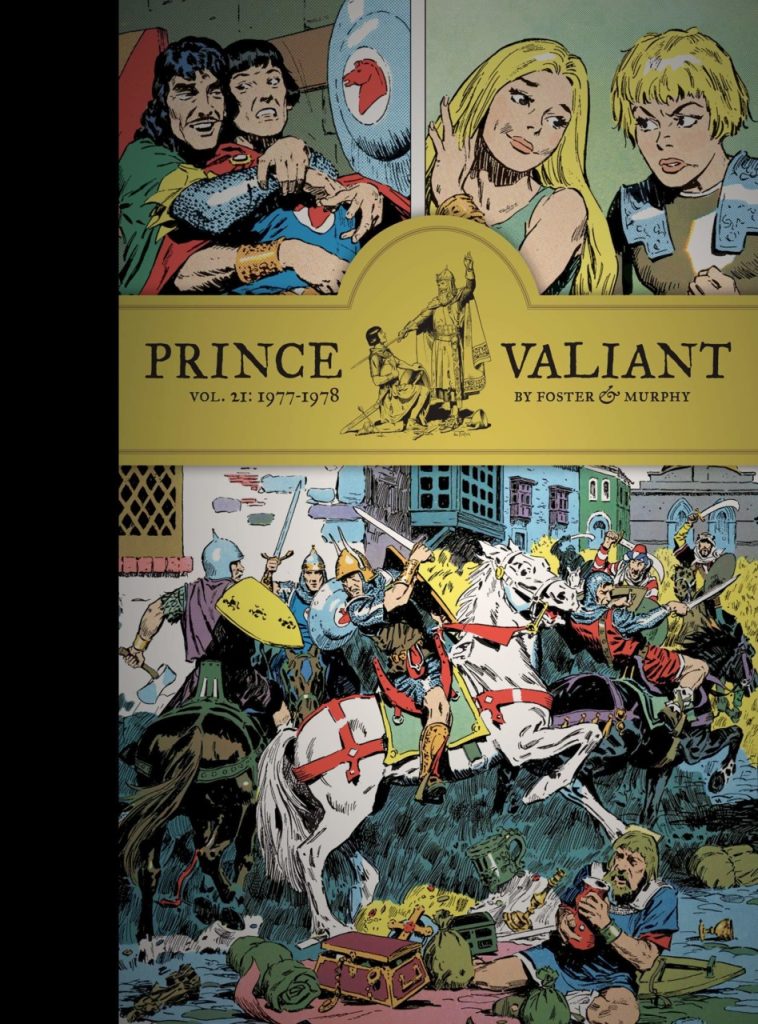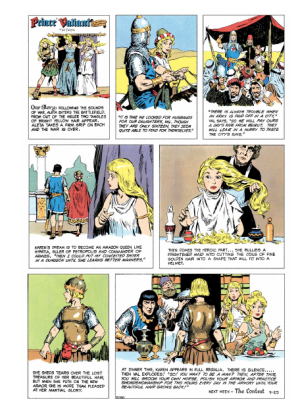Review by Frank Plowright
As the US bicentennial ended and 1977 arrived Prince Valiant continued smoothly along the path Hal Foster first set in 1937, with a page of quality artwork in service of an intriguing serialised adventure supplied to Sunday newspaper readers every week. Week after week John Cullen Murphy’s art maintains an outstandingly high standard, and even after so many years writing Prince Valiant Foster manages to keep the strip fresh within the parameters, helped by his early decision to keep the cast ageing.
One of Foster’s skills, perhaps under-rated considering he’s so good at everything, is varying the people who complicate Val and Aleta’s lives, and on occasion allies can prove as troublesome as foes. Such is the case of Gunthar, a young knight Val accompanies on a quest to retrieve treasures stolen from a church in the north and transported for sale in Jerusalem. His cause is just, as the robbery took place during a tragic sequence of events involving the death of Gunthar’s family, but Gunthar’s inflexibility proves problematical in other lands where customs are different. The messy conclusion to his mission features on the cover. Murphy just follows Foster’s lead by ensuring people are utterly distinctive, not just over a matter of a few weeks continuity, but from stories several years apart.
One of the earlier paperbacks featuring this material was Vol. 47: Queen of the Amazons, and while the story inspiring the title is relatively brief and the Queen barely features, it’s a memorable tale of a greedy conqueror led into a trap and so simply defeated. The lasting effect is that Foster now begins to differentiate Val’s twin teenage daughters, previously joint tormentors of young men, Karen is now determined to be an Amazon warrior, while Valeta prefers the more feminine approach.
From there Foster and Murphy supply the dangers of crossing areas of France before a return to Camelot and a tournament. Every few years one of those is on the agenda, but possibly concerned about repetition, Foster cuts it short, so there’s no great opportunity for Murphy to show the mounted participants charging at each other across the grass. No matter, as he provides so many thrills elsewhere.
The curtailment is due to Val’s pirate friend Boltar being captured and requiring rescued from what seems an impenetrable fortress. It’s over surprisingly quickly, ingeniously solved, but in a way some readers might feel avoids conflict. However, within parameters Foster’s approach is as realistic as possible, and would men throw their lives away when there was an alternative method? The main purpose is to have Arn and young Galan accompany Boltar back to Norway for a quiet pastoral series of pages, but Foster concludes them with the unexpected, and the shock will transmit over the decades to anyone’s who’s been reading every volume.
As the content moves to Vol. 22, the last with which Foster is involved, Arn is has headed into the country to discover the aged Hrothgar, who has connived to marry beautiful young woman via intimidation. Arn’s naturally chivalrous instincts demand a solution.
The other large sized paperbacks in which this material features are Vol. 48: Return to Camelot and the first few pages of Vol. 49: Road to Sorrow’s End.





